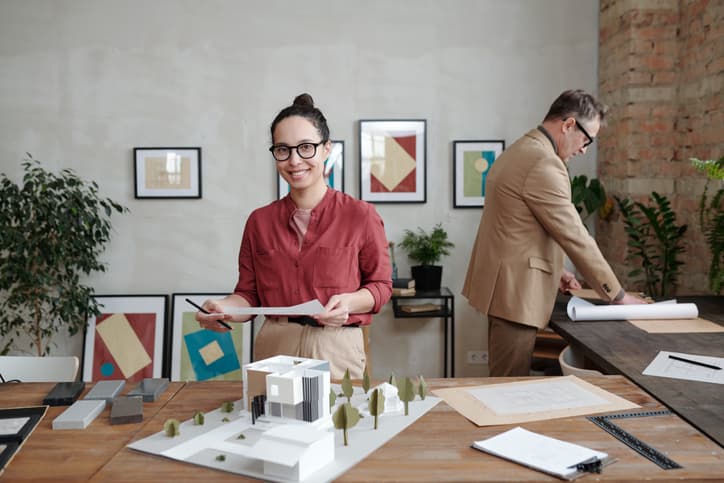
By: Liesa Stecher is the Chief Growth Officer at Addition
You might be a small business owner or startup founder. Perhaps you’re bootstrapping, or you might even be sitting on a million pounds of seed funding. Whatever the situation, you are building a business because you’ve identified a problem that you really want to solve. Building a brand is an integral part of that solution.
If branding sounds too pretentious (or simply too expensive), think about it this way: it’ll help you achieve the following 3 things:
- It tells people who you are
- It shows them what they can expect
- It helps you differentiate yourself
If you’re still not convinced whether you actually NEED a ‘brand’, let me be straight with you: a brand is an intrinsic part of ANY business. Even if you consciously make the decision to not have a brand, that would be your brand. So you might as well use it to your advantage.
When I start new brand projects, founders often talk to me about fancy websites, perfectly-curated social media campaigns, billboards and sponsorships. And that’s great. But there’s a time and a place for all of that.
In this article, I’ll give you some ideas and inspiration for setting foot on a budget-friendly path to good branding.
How to build a brand on a budget
Whenever I start a new branding (or rebranding project) I always go back to basics – the human basics, to be precise. We are social creatures, and the need to interact with each other is deeply rooted into our DNA. However, in 2021 we don’t limit our social interactions to humans – we also engage with brands.
On average, we are exposed to up to 10,000 ads per day. We’re so used to seeing hundreds of brands on a daily basis, they start to assume a “personality”.
That’s where your brand journey should begin. It’s not about what your brand is. It’s about who your brand wants to be.
Imagine your brand as a person. What role does it play among a group of friends? Is it the entertainer, the social magnet or the one observing from the corner? This will give you an initial idea of who you are (and who you want to be).
Once you have a rough idea about your brand’s personality, the real question time begins. I always structure this research into 3 parts:
- How do I sound?
- How do I look?
- How do I act?
How do I sound? The power of good copy.
Your brand personality will already give you an indication of how your brand should sound. But good copywriting will make your life a lot easier – so invest some time (and if you can money) to get it right.
Messaging
Messaging should be your first milestone in your brand journey.
When it comes to finding your brand message, simplicity is key. Don’t overcomplicate your messaging. No one will make the effort to decipher it.
I always use this mental image when I am on the hunt for concise messaging: Imagine you are at a protest and you only have one piece of cardboard to tell the world about what your business stands for. What would you write?
Give your message a purpose
Purpose-driven brands are here to stay. A purpose that goes beyond the transactional part of your business will give your brand another layer of personality and a sense of direction. Still struggling to identify your purpose? Have a go at Simon Sinek’s “Start with WHY”. He explains all there is to know in the topic – in a simple and concise (yep!) way.
Tone of voice
Now that you know your key message – how will you tell the world about it? This will literally set the tone for your brand and the way you communicate with your customers.
If writing is not your forte, work with a freelance copywriter to determine the basics of your tone of voice. Brands like Monzo also have their ToV guidelines on their website. This will give you an idea on what a ToV guide contains and how it’s structured.
If you want to keep costs down, you can do most of the messaging and tone of voice research yourself. Look at brands that you like (don’t worry about the sectors they’re in).
Which brands do you use? Do you follow? Why do you like them?
When I developed the ToV for Spring, I did my own research, and only brought a copywriter on board once I had a good idea of how I wanted the brand to sound.
2. How do I look? Be distinctive through design.
Design is daunting – no doubt about it. Here are a few guidelines that will help you find your look.
Start with a concept
For many founders and business owners, logo and brand design are both exciting and terrifying tasks. The big question I always get is “Where do you start?”.
I always recommend starting with a concept and building your brand around that. The best brands out there are the ones that “make sense”.
I’ll give you an example. I used to work for a big dating app group. One of our most successful apps is Bumble. If you’re not familiar with Bumble, it’s a “female first” dating app where the woman sends the first message to start a conversation.
The concept of Bumble starts with the name. A dating app is all about social interactions – and what’s nature’s perfect example for that? A bee hive! And on top of that, we all know who runs the (bee) world? Girls! There’s your first brand building block – and it’s a genius one!
Bumble’s main brand colour is a warm honey yellow. Their logo is inspired by the shape of a honeycomb. And their product features have branded names (their blog is called ‘Bumble Buzz’). Can you see how it all “makes sense”?
You might argue that Bumble is a huge brand with endless resources. You’re right – they are now! But the big brands all started somewhere. Nothing is hindering you to apply the exact same approach when building your own brand. Just ask yourself:
- Where can you take design inspiration from?
- What’s your company name?
- What’s your product/service?
- What’s your industry?
- What’s your purpose?
As business owners, we want to cut through the noise of competition. Design can be a great tool to accomplish this. Check what your competition is doing design-wise.
What logo designs do they have? What colour schemes? Is there an overall look? Can you use design to differentiate yourself?
I recently worked on the rebranding for Addition. It was a complete blank canvas, apart from the name – so that’s where I started. Addition perfectly described our “what” (we are an outsourced finance company for SMEs and startups), but not our ‘why”.
90% of startups will vanish within 5 years – not because of a useless idea or service, but because they run out of cash. That’s WHY we’re here. We help businesses take control of their finances and “make it add up”. Now we had a tagline.
Based on this concept, it was easy to create a logo around the ‘+’ symbol. Even our colours follow the same approach. They are a result of “adding” layers of blue, red and yellow – your typical finance colours. It just makes sense. Looking at competitors, many financial services firms had gone for muted, often uninspiring colour schemes. We went with bold, bright colours to insert some vibrancy, reflect the mindset of startup entrepreneurs and differentiate us from the competition.
Another example of this is when I worked on the rebranding of Spring (former Recyclabox). It all started with research of the industry and its main competitors. Spring is a tech startup that focuses on recycling and recirculating consumer electronics. As you can imagine, most competitors’ brands used green as their main colour. We consciously made the decision to stay away from the expected colour choice because our whole brand was about “doing recycling differently”.
3. How do I act? Where’s the party at?!
Now you know how to sound and look, think back to the ‘friends’ analogy again. You now need to decide which parties you want to attend, and what kind of people you want to meet.
Where does your ideal customer spend time – and how can you build a relationship with them?
As a starting point, it’s useful to develop 1 or 2 buyer personas (link). This will give you a better understanding of who your ideal customer is, what their pain points are, and where you can find them to tell them about your business (and the solution to their problems!).
Of course, brand activations depend on how much budget (and time) you have at your disposal. But no matter how big or small your brand campaigns are, consistency is key. It’s better to do a few things right, rather than cover it all and do a mediocre job.
You don’t have the time for Tik Tok? Then don’t do it.
You’ve identified Instagram to be the platform where your ideal customers are? Then put the effort there. Don’t even think about having a TikTok strategy for now – because it’s just you doing it all!
When people check your socials (and they will), they will notice that your IG is amazing and your other socials are boring and patchy. It will make you look inconsistent and less trustworthy. Cut them for now. Grow your business and get back to it when the time is right.
Pro tip: Invest in templates
If you have £300-£500 spare, then I highly recommend getting a freelance graphic designer to build templates for your social media channels. Not only will this save you so much time, it also gives you consistency and will make you look like a professional brand.
Once you’ve taken these steps, you might be wondering how to gauge success. To avoid second-guessing yourself, weigh your choices against these 3 elements of an effective brand.
3 elements of an effective brand
1.Accurate but aspirational
As a business (and a brand), you definitely want to be aspirational, amaze your customers and take them with you on your business journey. However, no one likes a talker. Don’t promise or discuss things that may never happen, just to generate attention.
For example: you might have the most amazing USP, but if your customer service doesn’t reply to an inquiry for 7 days, it doesn’t add up. Your brand loses trust, and your leads will move on (and likely never come back).
2.Simple but significant
I know this sentence is used far too many times, but less is definitely more when it comes to branding. Whether it’s your messaging, your colours or your logo, make it simple and concise. Think of the cardboard at your rally. Only tell people what they really need to know.
3.Keep it consistent
Know what you can do and do it well – over and over again. Don’t try to do it all just because others have it all covered (or so it seems). They might have a 5-person marketing team, a recent investment – or simply have been around a lot longer than you.
Of course, there’s no harm in checking out the competition. But don’t crumble under pressure. Focus on your path. Take it step by step, and keep delivering.
In Conclusion
Don’t wait until your brand is perfect before launching it – because it never will be! And it doesn’t need to be, either.
If you think you need a perfect brand to make your business a success, just look at Airbnb, Revolut or Spotify. They all went through multiple “rebrands” after they had proven their business case. Yes, they had a brand when they launched – but it always played a supporting act, never the main role.
We learn new things every day. Most of us would say that we’re not the same person we were 10 years ago. The same goes for your brand. Branding is a process. It’s about knowing who you are as a business and where you want to be, the rest you’ll figure out trying. So be kind to your brand, be open to change and have fun!
About Author:
Liesa Stecher is the Chief Growth Officer at Addition. She is a brand marketing expert who has worked with major companies such as Conde Nast International, as well as startups including Lumen and Spring.


